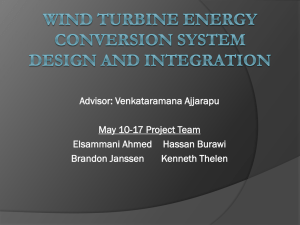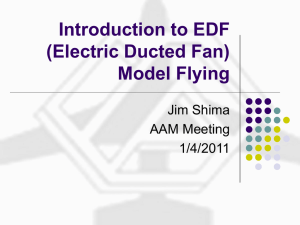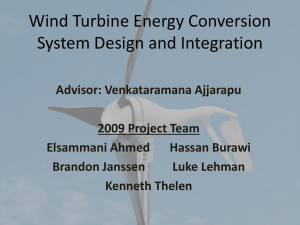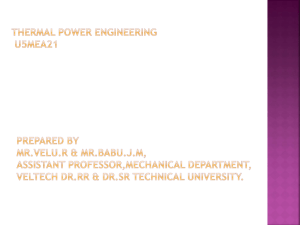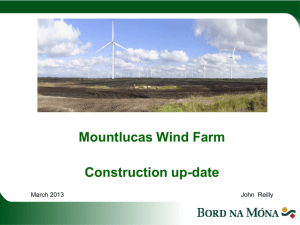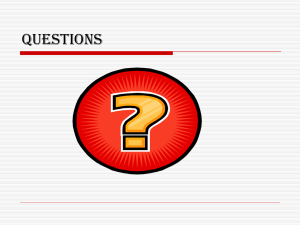Introduction To Turb..
advertisement
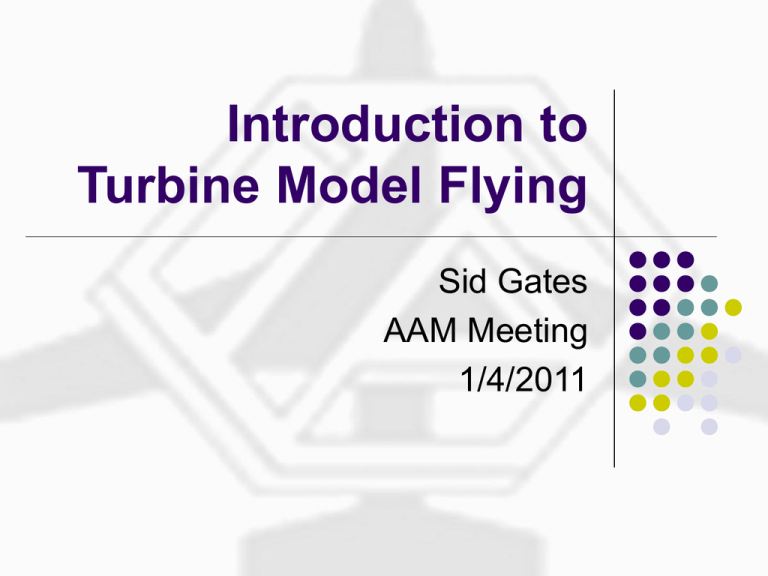
Introduction to Turbine Model Flying Sid Gates AAM Meeting 1/4/2011 Turbine Engine Components Most current production engines are Single Shaft with an annular combustor. The Single Stage Centrifugal Compressor is driven by a Single Axial Flow Turbine Wheel. The shaft is supported by two lubricated, preloaded angular ceramic ball bearings Turbine Engine Disassembly Compressor and turbine wheel installed on the shaft No bearings shown. Turbine Combustor Annular Combustor – The combustion chamber is made out of stainless. The hole pattern is designed to control the size and shape of the flame in the chamber. Side View Combustor with Injectors Fuel feeds in through the small tube shown on top and goes into a fuel manifold that goes around the back of the combustion chamber. Twelve stainless fuel injector needles are silver soldered into the fuel manifold. The ends of the needles are placed into the rear of the twelve vaporizer tubes. The vaporizer tubes are soldered to the back of the combustion chamber and run approx. ¾ of the way to the front of the combustion chamber. Vaporizer tubes atomize the fuel for sustaining “well-behaved” flame Side View Turbine ECU An Electronic Control Unit (ECU) monitors exhaust gas temperature, RPM, ambient pressure and controls the fuel pump voltage. The miniature fuel pump in turn controls turbine speed (thrust) by varying its RPM and the fuel flow rate. The ECU acts as an electronic speed control so that fuel pump speed is proportional to the transmitter throttle stick position. Turbine Compressor The spinning compressor pumps air into the case. Air is compressed (density increased) and passed to combustor for fuel/air mix. The diffuser shown below straightens the air flow as it goes into the case. The sleeve that houses the shaft is shown attached. Turbine Engine Disassembly 6 The diffuser is shown on the front (left) of the combustion chamber and the Nozzle Guide Vane (NGV) on the back (right) of the chamber. Turbine Engine RAM 500 engine disassembled (~12 lb thrust) Turbine Operation Test stand with engine and all components necessary to run. The engine can be run from the data terminal or the transmitter. The start/run sequence to be described is for the RAM 500, others vary slightly. Start Up Sequence The start up sequence can be initiated by the Data Terminal or the Transmitter. First the electric starter motor spins the engine up to approximately 6,000 RPM then cuts off. The engine is allowed to coast for a short time and then the ECU pulses the propane (gas) solenoid and lights the glow plug. Start Up Sequence (cont) The propane lights and the engine accelerates to approx. 15,000 RPM. If the RPM and temperate are rising the ECU starts pumping fuel (Kero or Jet-A). The Data Terminal will then display “RAMPING”. When the engine reaches 50,000 RPM the Terminal will display “RUNNING” and you have transmitter control of the engine. Model Suggestions You have the best chance of success if you start with a trainer jet such as the Boomerang Sprint ($795.00) for the 12-22 lb thrust engine. If you start with a larger engine the Boomerang Elan or XL are very good choices. Slower landing speed and lighter wing loading. If you are only interested in a military scale model I recommend the Top Gun F15 or any F-15 available (Yellow, Fei Bao, Avonds) A slightly higher performance choice and the lowest initial cost is the Tornado package offered by Modellbau USA Tornado Sport Jet Comb Package Model is a redesign of a model that re- quired a lot of mods for turbine operation. Engine is a proven design. Choosing the Right Engine 1. 2. 3. 4. Decide on your budget. Decide what size models and whether Sport or Scale. Your model choice will dictate the size of Engine. Chose the brand of Engine. Main Stream Brands: Jet Cat WREN Jet Central Newcomer: Kingtech Purchasing New vs Used: There has been rapid improvement in engine design the past few years. Faster acceleration, lighter weight and better fuel economy. Make sure you know the engine designs short comings if buying an older used engine. ASK/CONFIRM used engine has not been in crash or if was serviced afterwards Web searches are a good place to research an engine. AMA Turbine Waiver Summary Turbojets and Turbofan single engine models shall not exceed static thrust of 45 lbs. & multi engine shall not exceed 50lbs combined RC fixed wing aircraft: The maximum velocity will be 200 mph. All radios must be equipped with fail safe and the ECU shall be configured to shut down the engine within 2 seconds of fail safe activation. An experienced turbine pilot is defined as a pilot who has completed 20 or more turbine flights during the preceding 24 months and who has a current turbine waiver issued by AMA. For confirmation purposes, the pilot is required to keep a written log of all flights and will provide copies to AMA upon request. An AMA member may be permitted to fly a turbine powered model on the slave transmitter of a buddy box as long as the master transmitter is operated by an experienced turbine pilot. All turbine waiver applicants should have accomplished at least 50 flights on a high performance model. Fixed wing: Model should be capable of sustained speeds of 100 mph or higher. AMA Waiver Flight Demo The purpose of the flight test for the turbine applicant to demonstrate their skills, knowledge, and understanding of how to safely operate and fly a turbine model aircraft. Key Elements: The following elements are to be demonstrated through action along with verbal discussion of the element where appropriate. 1. Demonstration of proper turbine ground operations a. b. c. d. Discuss the need to keep the tailpipe area clear of people and flammable items during start, shutdown, and all ground operations. Explain the response plan for dealing with an aircraft fire similar to one resulting from a hot start. Fire extinguisher to be present per AMA safety regulations. Explain the potential for a post crash fire and the response plan to deal with the situation. Explanation to include local fire department contact number and fire fighting equipment immediately available for the modeler to respond to the fire. Explain and demonstrate typical turbine startup and shutdown procedures. AMA Waiver Flight Demo (cont) 2. Flight Skills a. b. c. d. e. f. Takeoff, to be held within 10 feet either direction of centerline, with smooth, controlled corrections as necessary. Horizontal Figure 8. Pilot to hold altitude to within +/- 50 feet during the Figure 8. This demonstrates skills at both left and right hand patterns and the ability to control the models flight path. Perform two aerobatic maneuvers with combined looping and rolling elements to be selected by the turbine applicant. Examples include Cuban 8, Humpty Bump with ½ roll, or similar maneuvers. This demonstrates the general flying skills of the modeler. High Speed Circuit of the field performed at a safe high rate of speed. This demonstrates the ability to control a model aircraft at speed. Square Traffic Pattern including a missed approach go-around. This maneuver to be in the opposite direction of the takeoff and landing if conditions allow. This demonstrates the ability to control a model aircraft in the landing approach mode. Landing to a complete stop. Again, smooth, controlled corrections to the aircraft’s path after touchdown are required. The landing must be completed on the runway. * At no time during the flight shall the aircraft pass behind the designated safety line.


